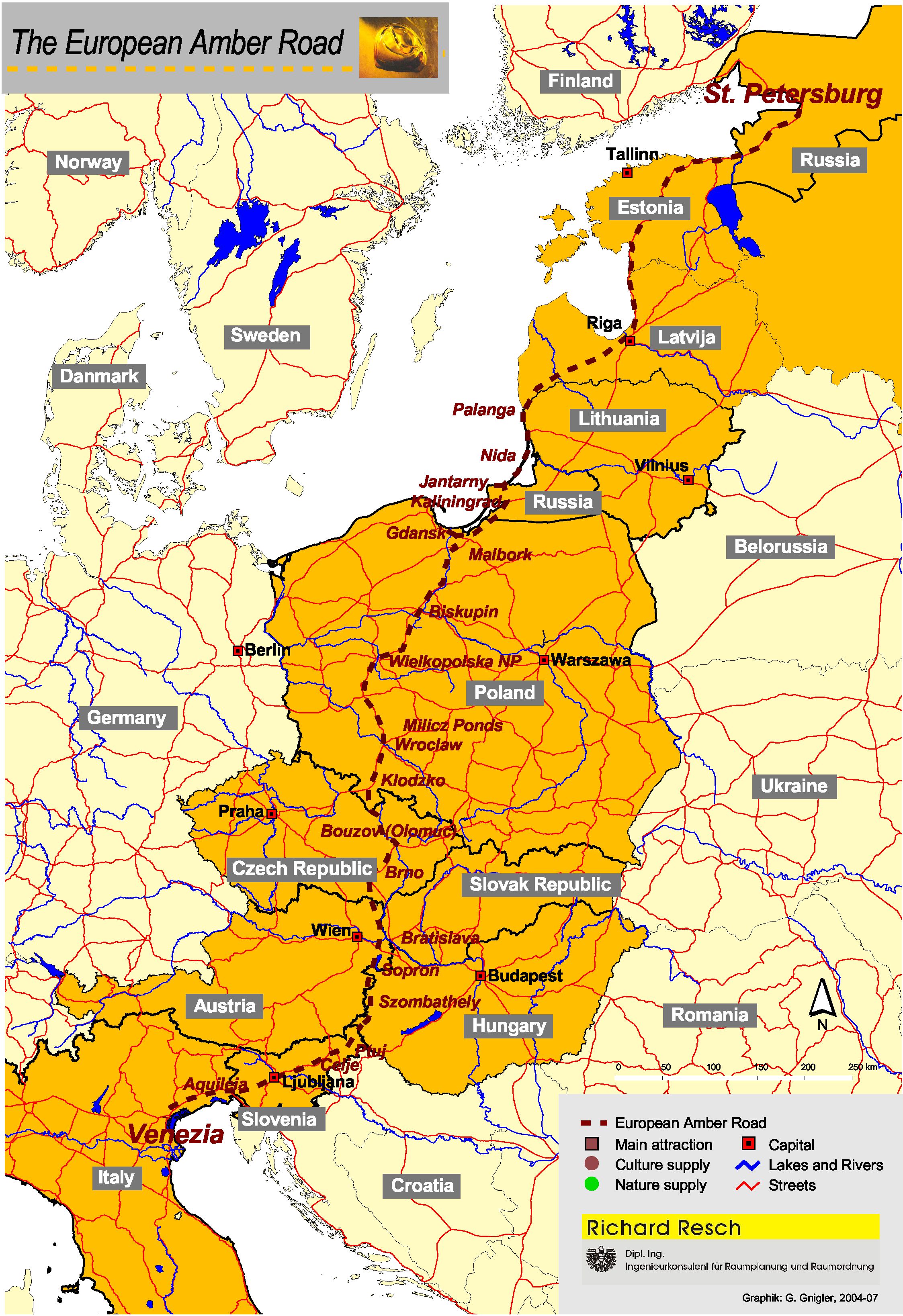As written in my last month issue the Romans reached what is now southern & central Poland as merchants using the "Amber route", but also as legionaries.
Indeed archeologists have recently done discoveries that confirm the military presence of the Romans in the area north of the Oder river (see https://www.thefirstnews.com/article/romans-roamed-the-kujawy-region-of-poland-new-discoveries#:~:text=An%20unprecedented%20discovery%20has%20for,than%20had%20previously%20been%20assumed.) and also near the village of Malawa near the border with Ucraine (see https://www.express.co.uk/news/science/1380625/ancient-coin-archaeology-roman-emperor-hadrian-denarius-poland-evg).
The "amber route" in Poland. The city of Kujamy is near Biskupin
Additionally it is noteworthy to pinpoint that also in the area od what is now southern-central Poland there are evidences of Roman military presence: numerous Roman military artifacts dating as far back as the 1st century A.D. have been unearthed in Kujawy, central Poland.
This is a region in the Vistula basin far outside the boundary of imperial Rome even at its greatest extent under Trajan in the early 2nd century.
According to historian Cassius Dio, Roman cavalry may have made in appearance in what is now Kujawy in the late 1st century, and it was the "Lugii" themselves who called this cavalry.
Around 91 AD, the german tribe of the "Lugii" (related also with the "Vandals") made an alliance with Rome and asked the emperor Domitian to send troops to aid in their fight against the "Suebi" tribe. Domitian agreed in a desultory fashion and sent a measly 100 horsemen. Dio does not mention them any further, so there’s no way to know if they arrived, fought, returned or anything else. The territory of the Lugii, as far it can be determined, seems to have extended further to the south of modern-day Kujawy, so even if the horsemen went to their aid as promised, they could well have been a long way away from the find site. If they did make it, they would be the first Roman soldiers recorded in what is today Poland.
Furthermore, Pliny mentions Nero sending a trading expedition to the Baltic, but nothing about a military escort. Still, a highly valued trade route, like the "Amber route" winding through the territories of many and varied tribes with little political stability and a tendency to engage in hostilities, could certainly have used some securing. The Kujawy might be evidence that Rome sent legions to keep the amber coming.
In 2018 Polish archaeologists found traces of Roman presence in Kujawy to treasure hunters, who donated some of their findings. The majority of discovered artefacts comes from the area between the villages of Gąski and Wierzbiczany (Kuyavian-Pomeranian province of Poland).
"This is the first strong evidence of the actual presence of Roman soldiers in the territory of today`s Poland" - believes Dr. Bartosz Kontny of the Institute of Archaeology, University of Warsaw.
Among the unique monuments are metal pendants that decorated the straps of the Roman horse gear. They were in the shape of phalluses or vulvas (female womb). "These amulets were believed to ensure happiness and protect against evil forces, they had apotropaic meaning" - said Dr. Kontny.
As a truly unique object among the analysed artefacts, the archaeologist mentions a gold-plated copper application for a hip belt. It depicts a spear of a beneficiarius, a high-ranking officer of the Roman army. "It was an attribute of his power" - says the archaeologist.
Such a large accumulation of similar Roman objects in other places in the barbarian Europe -like in central Germany (where, for example, the local population was recruited to the legions)- is clearly associated with physical Roman presence.
Finally, two Roman coins were discovered in 2016 – one in Lelów and one in Borowa – during archaeological research on the "Przeworsk culture" settlements in these villages. Both villages are located in the region of Częstochowa, Silesian Voivodeship near Krakow: Lelów, in the Upper Pilica Basin, and Borowa, in the Liswarta Basin. Other stray groups of Roman coins, obtained via activity by treasure hunters, have been registered in this region. Roman coin finds from this area are like in other parts of Lesser Poland ( https://www.archaeology.org/news/8577-200407-poland-roman-coins and all this shows a possible (or certain, according to some scholars) presence of roman merchants -and may be soldiers- in the area.
Possible legionary presence in southern Poland
In 172 AD roman emperor Marcus Aurelius conquered western Slovakia, attacking & subjugating the local Marcomanni and the Quadi. But in 177 AD, the Quadi rebelled, followed soon by their neighbours, the Marcomanni and Marcus Aurelius once again headed north, to begin his second Germanic campaign (secunda expeditio germanica). He arrived at Carnuntum in August 178 AD, and set out to quell the rebellion in a repeat of his first campaign, moving first against the Marcomanni, and in 179-180 AD against the Quadi.
A Roman inscription in Laugaricio, ordered by Marcus Valerius Maximianus, near the border Slovakia-Poland (178–179 AD). The inscription marks the -certain- northernmost roman presence in this area of central Europe.
Under the command of Marcus Valerius Maximianus, the Romans fought and prevailed against the Quadi in a decisive battle at Laugaricio (modern Trenčín, Slovakia, near the border with Poland). The Quadi were chased westwards, deeper into Greater Germania and probably the "Auxiliary of Legion II" reached the Oder river in what is now Poland, where the praetorian prefect Tarutenius Paternus later achieved another decisive victory against them. But on 17 March 180, the emperor died at Vindobona (modern Vienna) -because of plague- and the Romans went back south of the Danube river.
The place of this victory of Tarutenius Paternus has not been identified, but it seems to have happened around the city of Katowice. Some roman vestiges of military material has been discovered in 2022 in the area. However there are researches going on, made mainly by Slovakian and Poland archaeologists in 2025 (read: https://archaeologymag.com/2025/02/roman-sword-found-in-southern-poland/ ; https://www.ancient-origins.net/news-history-archaeology/roman-burial-kazimierza-wielka-0021466 and https://allthatsinteresting.com/ksiezpol-poland-roman-coins).
Map of the roman empire under Augustus, showing the "client states" of the Marcomanni/Quadi and the Semnones (a german tribe who probably occupied the territories around the southern Oder river, now in southwestern Poland)


Very interesting
ReplyDelete